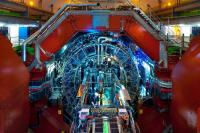Co-operation of the Warsaw University of Technology with CERN

ALICE is the name of one of the detectors in the Large Hadron Collider and of the experiment in which our scientists, among others, are involved; photo: Antonio Saba, CC BY-SA 3.0, Wikimedia Commons
On July 1, 2021 Poland has been a full member of CERN - a European scientific organization dealing with the study of matter - for exactly 30 years. Scientists from our University have been making an important contribution to the work of the centre.
If you were to conduct a street probe on CERN, many answers would probably associate it with the Large Hadron Collider (LHC) - the world's largest particle accelerator. This is where projects which are important for broadening our knowledge of the Universe are implemented. The research results are widely commented on and find their applications in many industries - from electronics to medicine.
For such discoveries to be possible, specialized equipment and experienced researchers are needed. Polish specialists have always been a strong group among scientists working and cooperating with CERN.
Examples of projects in which WUT researchers have taken or are taking part:
ALICE
ALICE is one of the detectors in the Large Hadron Collider. Our scientists have participated in the experiment from the very beginning of data collection. Its main goal is to find an answer to the question which is the foundation for understanding the mechanism of strong interactions in nature. Its goal is observing the transition of nuclear matter into a state in which quarks and gluons are not bound in complex systems (hadrons), but appear in the form of the so-called quark-gluon plasma.
In 2020, our scientists joined the international team of authors of the publication in Nature on strange quarks, and more precisely on interactions of protons with ksi and omega particles – elements which are difficult to study, consisting of two and three strange quarks, respectively.
More about the ALICE experiment
CMS
CMS is a detector in the Large Hadron Collider used, inter alia, for observing muons. A group with the participation of, among others, scientists from the Warsaw University of Technology are responsible for the design, construction and maintenance of the muon triggering system, operating on the basis of the RPC muon chambers (RPC TRIGGER). The team also analyses the decay of the Higgs boson into two tau leptons and the processes of pp scattering at small angles.
AEgIS
The aim of the experiment is to measure the gravitational drop of the anti-hydrogen pulse beam. The WUT group plays a leading role in the design and implementation of a new control and acquisition scheme based on quantum electronics.
More about the AEgIS experiment
NA61/SHINE
This is an experiment conducted at the SPS accelerator. One of the main points of the program of this physical experiment is the study of the state of the matter present in the initial phase of the existence of the Universe, i.e. the so-called quark-gluon plasma. The scientists are looking for the so-called critical point of phase transition to plasma. Currently, NA61/SHINE is undergoing improvements in which scientists from WUT have a large share.
More about the NA61 / SHINE experiment
COMPASS
This is an experiment that uses the beam from the SPS accelerator. COMAPASS’ goal is to study the nucleon structure and hadron spectroscopy. COMPASS-II - an extended research program - is expected to provide new and unique information about the three-dimensional structure of the nucleon, as well as the role of the orbital angular momentum of quarks in explaining the spin structure of the nucleon. In turn, hadron beams (pions, kaons, protons) are used for the spectroscopy of hadrons produced in the interaction of these beams with non-polarized targets.
More about the COMPASS experiment
Poland's full membership in CERN means that it is also our laboratory and our experiments. It can thus be said that scientists and students from the Warsaw University of Technology go to Geneva as if they were going to their own centre.
Please visit the website about the 30th anniversary of Poland at CERN, where you can find more information about the implemented projects and the scientists involved in them.







